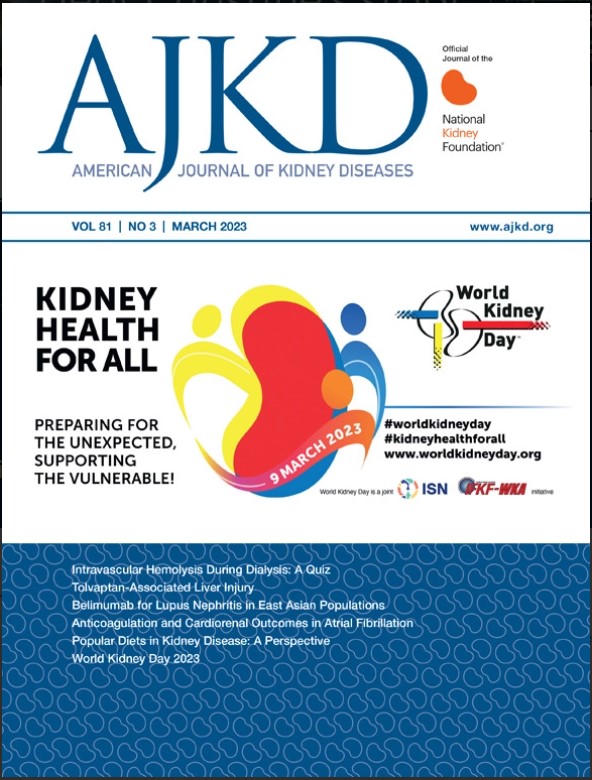Trends in Kidney Allograft Failure Among First-Time Transplant Recipients in the United States
IF 9.4
1区 医学
Q1 UROLOGY & NEPHROLOGY
引用次数: 0
Abstract
Rationale & Objective
The management and outcomes of kidney transplant recipients have evolved over the past 3 decades. This study of US patients whose first kidney allograft failed examined long-term trends in subsequent waitlisting, retransplantation, and all-cause mortality.
Study Design
Retrospective cohort study.
Setting & Participants
Patients recorded in the US Renal Data System (USRDS) whose first kidney allograft failed between 1990 and 2019.
Exposure
The 5-year period in which the allograft failure occurred: 1990-1994, 1995-1999, 2000-2004, 2005-2009, 2010-2014, or 2015-2019.
Outcome
(1) Waitlisting for retransplantation, (2) retransplantation, and (3) all-cause mortality following first allograft failure.
Analytical Approach
Competing risk survival analyses with the approach described by Fine and Gray used for the outcomes of waitlisting and retransplantation, and Cox proportional hazards models used for the outcome of all-cause mortality.
Results
The absolute number of patients whose allograft failed and who started dialysis increased from 3,197 in 1990 to 5,821 in 2019. Compared with 1990-1994, the rate of waitlisting for a second transplant increased with each subsequent 5-year period, peaking between 2005 and 2009 before decreasing again subsequently. The rate of retransplantation following allograft failure decreased by 9%, 14%, 18%, 7%, and 11% in the sequential 5-year eras; and the mortality rate was 25% lower in 2015-2019 (HR, 0.75 [95% CI, 0.72-0.77]) compared with 1990-1994. Women had a reduced rate of waitlisting (HR, 0.93 [95% CI, 0.91-0.95]) and lower rate of retransplantation (HR, 0.93 [95% CI, 0.91-0.95]) compared with men. Compared with White patients, African American and Hispanic patients had significantly lower rates of waitlisting, retransplantation, and mortality.
Limitations
Retrospective data that lacks granular clinical information.
Conclusions
During the past 3 decades, among patients whose first kidney allograft failed and subsequently initiated dialysis, the rates of waitlisting for retransplantation increased while the rates of retransplantation and mortality decreased. Disparities based on race, ethnicity, and sex in waitlisting and retransplantation were observed and warrant further investigation.
Plain-Language Summary
Kidney allograft failure constitutes the fourth most common cause of dialysis initiation in the United States, and it accounts for 4% to 10% of yearly new dialysis starts globally. Little is known about the trends in the outcomes of patients whose kidney allograft failed. We studied US patients whose first kidney allograft failed between 1990 and 2019 to understand trends in waitlisting for retransplantation, retransplantation, and all-cause mortality after kidney allograft failure. Among patients whose first kidney allograft failed and started dialysis, rates of waitlisting increased and rates of retransplantation and mortality decreased over the past 3 decades. We found racial, ethnic, and sex-based disparities in outcomes. Compared with White patients, African American and Hispanic patients had significantly lower rates of waitlisting, retransplantation, and mortality. Women also had lower rates of waitlisting and retransplantation compared with men.
美国首次接受肾移植者肾移植失败的趋势。
理由和目标:在过去的三十年中,肾移植受者的管理和治疗效果发生了变化。本研究对首次肾脏异体移植失败的美国患者进行了调查,旨在了解他们在后续等待、再次移植和全因死亡率方面的长期趋势:研究环境和参与者:美国肾脏登记处记录的患者:美国肾脏数据系统(USRDS)中记录的1990年至2019年间首次肾脏同种异体移植失败的患者:1990-1994年、1995-1999年、2000-2004年、2005-2009年、2010-2014年或2015-2019年:1)等待再次移植,2)再次移植,3)首次同种异体移植失败后的全因死亡率:分析方法:采用Fine和Gray所描述的方法对等待移植和再移植结果进行竞争风险生存分析。对全因死亡率结果采用了Cox比例危险模型:异体移植失败并开始透析的患者绝对人数从1990年的3197人增加到2019年的5821人。与 1990-1994 年相比,第二次移植的等待率在随后的 5 年中逐年上升,在 2005-2009 年间达到顶峰,随后再次下降。异体移植失败后的再次移植率在随后的5年中分别下降了9%、14%、18%、7%和11%;与1990-1994年相比,2015-2019年的死亡率降低了25%(HR=0.75,95% CI,0.72-0.77)。与男性相比,女性的等待率降低(HR 0.93,95% CI 0.91-0.95),再次移植率降低(HR 0.93,95% CI 0.91,0.95)。与白人患者相比,非裔美国人和西班牙裔患者的候选率、再移植率和死亡率明显较低:局限性:回顾性数据,缺乏详细的临床信息:结论:过去三十年间,在首次肾脏异体移植失败并随后开始透析的患者中,等待再次移植的比例上升,而再次移植的比例和死亡率下降。在等待移植和再移植方面,观察到了种族、民族和性别差异,值得进一步研究。
本文章由计算机程序翻译,如有差异,请以英文原文为准。
求助全文
约1分钟内获得全文
求助全文
来源期刊

American Journal of Kidney Diseases
医学-泌尿学与肾脏学
CiteScore
20.40
自引率
2.30%
发文量
732
审稿时长
3-8 weeks
期刊介绍:
The American Journal of Kidney Diseases (AJKD), the National Kidney Foundation's official journal, is globally recognized for its leadership in clinical nephrology content. Monthly, AJKD publishes original investigations on kidney diseases, hypertension, dialysis therapies, and kidney transplantation. Rigorous peer-review, statistical scrutiny, and a structured format characterize the publication process. Each issue includes case reports unveiling new diseases and potential therapeutic strategies.
 求助内容:
求助内容: 应助结果提醒方式:
应助结果提醒方式:


